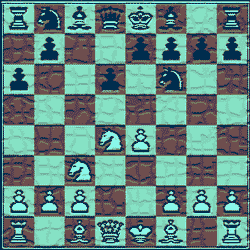Giving the Najdorf the Slip
by Aditya
(Patna, Bihar, India)
The Sicilian Defense, according to me is the easiest as well as the hardest defense technique of all. I say easiest, because it can be used as the first block or the foundation block for any budding chess player. And, hardest, because like any other opening, it has multitudes of variations. Personally speaking, it’s my favorite, and with the Najdorf variation, it could be lethal.
First analyzed by Guilio Polerio in 1594, the Sicilian Defense has been in regular use by all the great chess masters since then. The list includes Louis-Charles Mahé de La Bourdonnais, Adolf Anderssen, Howard Staunton, Louis Paulsen, Carl Jaenisch, Emanuel Lasker, Frank Marshall, Savielly Tartakower, Aron Nimzowitsch, Max Euwe, Capablanca and Tarrasch. The popularity of Sicilian Defense in the late 20th century goes mainly to Fischer and Kasparov.
It is also the most played opening of my favorite chess player, Vishwanathan Anand. He has played the Sicilian 449 times with White and 238 times from the Black side. One of the most memorable games of Vishy, which involves the Sicilian, is the one he had against Garry Kasparov in Tilburg in 1991. This Sicilian game included the Scheveningen Variation (B82). Although, Vishy was not able to hold much ground against Kasparov ever, this game does bring the classic Anand to the fore.
Vishy Anand - Garry Kasparov
Tilburg, Netherlands - 1991
1.e4 c5 2.Nf3 d6 3.d4 cxd4 4.Nxd4 Nf6 5.Nc3 a6
After a copybook opening the real match starts. At this juncture, Kasparov plays the Sicilian Najdorf, which happens to be his favorite too. The game continues
6.f4 e6
If, at this juncture, he had transposed to Scheveningen Variation. 6…e5, it would have led to the Najdorf.
7.Bd3 Nbd7 8.0–0 Qb6
Some, might be surprised, while others confused, as to why would one go for this move. After all 8...Be7 would have been much safer.
9.Be3 Qxb2 10.Ndb5
Again a big surprise. Why did he not go for 10.Qd2 Ng4.
10...axb5 11.Nxb5!
Now, we know why Kasparov did not go for Najdorf. This is his improvement.
Ra5!
is a great response from Vishy. Evidently, Kasparov did not prepare for this move. 11...Qb4? 12.Nc7+ is bad for Black. Then came the predictable move of
12.Rb1! Rxb5
Forced. 12...Qxa2? loses to 13.Nc3 Qa3 14.Rb3+-.
13.Rxb2 Rxb2 14.Qa1 Rb6
because 14…Rb4?? 15.Qc3! would have led to an outright victory for White.
15.Bxb6 Nxb6 16.Qc3! Be7 17.Rb1 Nfd7! 18.Qxg7 Bf6 19.Qh6 Ke7?
For this move Kasparov’s reasoning is that Black should first play 19...Rg8 preventing the g4 advance by White.
20.Bb5?
The bishop vacates the d-file for the heavy pieces and also prepares the advance e5. But, White misses a terrific attack with 20.g4!!
20...Rg8?
another alternative was 20...Bd4+? 21.Kf1 Nc5 22.Rb4+-; or 20...Nc5? 21.e5 dxe5 22.g5+-; If Black had played 20...e5! 21.Rf1 Rg8 22.fxe5 Bxe5 23.Qxh7 Rg7 24.Qh4+ Nf6, he would have had the upper hand.
21.Rd1!
This move seems right.
21...e5? 22.f5!
In all probability Kasparov didn't see the necessity of ...Rd8 and instead chose the following move.
22...Nc5??
Another blunder. 22...Rd8 would have been better.
23.Rxd6 Bg5
Chessmaster engine tells me that a better move had been 23...Kxd6 followed by 24.Qxf6+ Kc7 25.Qxe5+ or 25.Qxf7++-.
24.Qxh7 Nxe4 25.Rxb6 Rd8
Kasparov later wrote that this move surprised even him. He said that this move was not a good one. The alternative given by him is 25...Be3+? 26.Kf1 Rg4 27.f6+ Kf8 28.Ke2!+-
26.Bd3 Be3+ 27.Kf1 Bxb6 28.Bxe4 Rd4 2 9.c3!
This move seals it as White wins the game hands down. 29...Rxe4 would have been outclassed by 30.f6+
1-0
Play through this wonderful Anand classic for your own enjoyment.









